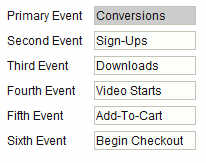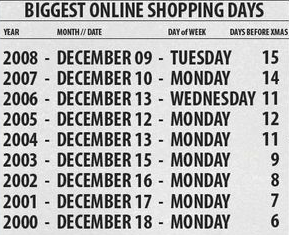Cyber Monday is over, but the damage it could have done to your paid search campaigns isn’t. The National Retail Federation estimates that 11 million more people planned to shop on Cyber Monday, a 14% over last year. This is just the beginning of the holiday rush. If you optimize now, you can make the most of the holiday season. Here are our 5 favorite retail cures:
 Separate Out Your Brand Terms From Brand Plus Terms – Some of the fastest rising queries this holiday weekend were “Walmart Black Friday” and “Target Black Friday Deals Online”. . These are “brand plus” terms: some version of your brand modified. It’s the plus part of these search queries that can skew your performance and analysis. . Is a search for “walmart online” as valuable as “walmart black friday deals” or “walmart bath towels”? Can you effectively target them all with one text ad? Would you want to send all to the same landing page? . The answer to all three is, obviously, not. Many retailers lump together their brand terms with category terms with brand ones (ex: a Bath Towels ad group that includes “walmart bath towels”) or fail to separate out obviously different brand terms (ex: www.walmart.com). . Improve your targeting and analysis by separating your brand terms into unique ad groups and campaigns. Start here for some ideas. .
Separate Out Your Brand Terms From Brand Plus Terms – Some of the fastest rising queries this holiday weekend were “Walmart Black Friday” and “Target Black Friday Deals Online”. . These are “brand plus” terms: some version of your brand modified. It’s the plus part of these search queries that can skew your performance and analysis. . Is a search for “walmart online” as valuable as “walmart black friday deals” or “walmart bath towels”? Can you effectively target them all with one text ad? Would you want to send all to the same landing page? . The answer to all three is, obviously, not. Many retailers lump together their brand terms with category terms with brand ones (ex: a Bath Towels ad group that includes “walmart bath towels”) or fail to separate out obviously different brand terms (ex: www.walmart.com). . Improve your targeting and analysis by separating your brand terms into unique ad groups and campaigns. Start here for some ideas. . Tag and Analyze Multiple Conversion Events – Google’s Retail blog reported an interesting trend that “searches for “printable coupons” on Thanksgiving and Black Friday were up about 50% over last year. Google Search was also used to develop in-store shopping strategies, as “Walmart Black Friday Store Map” surfaced as a fastest rising term, blurring the lines between online and in-store shopping.” . This isn’t surprising to anyone who regularly reviews their search queries (see point #3), but it can be a real eye opener to exec who see a surge in traffic (and cost), but a decrease in conversions. . If you just analyze online sales, then the knee jerk reaction is to decrease bids as soon as conversions go down or pause words that don’t convert. But, you could be analyzing only a part of the value. . Chances are you have micro-conversions on your site that correspond to some value in offline sales or future sales:
Tag and Analyze Multiple Conversion Events – Google’s Retail blog reported an interesting trend that “searches for “printable coupons” on Thanksgiving and Black Friday were up about 50% over last year. Google Search was also used to develop in-store shopping strategies, as “Walmart Black Friday Store Map” surfaced as a fastest rising term, blurring the lines between online and in-store shopping.” . This isn’t surprising to anyone who regularly reviews their search queries (see point #3), but it can be a real eye opener to exec who see a surge in traffic (and cost), but a decrease in conversions. . If you just analyze online sales, then the knee jerk reaction is to decrease bids as soon as conversions go down or pause words that don’t convert. But, you could be analyzing only a part of the value. . Chances are you have micro-conversions on your site that correspond to some value in offline sales or future sales:
- Printable Store Maps or Circulars
- Email Newsletter Signup
- Store Locators
- Find Local Ads .
tEach of these events need to be tagged and considered when you’re evaluating the effectiveness of your account. Sure, not everyone is as valuable as an online sale. And, yes, you can’t always perfectly tie them to revenue. That’s okay. Awareness is the first step. . Once you know, you can at least make an educated guess about the value/cost of keeping these keywords live. Plus, you now have a real reason and focus on closing your offline/online analytics gap.
- Mine Your Search Queries – Holidays tend to bring out very specific search queries. Queries for deals, hours and hot products pop up more rapidly than in the rest of the year. Chances are that you’re using Broad or Phrase match. It’s almost a certainty, then, that you’re paying for searchers you can’t convert. . Take the time now to mine your search queries, the actual words someone types, not just the keywords you buy. Sort the list of your queries by cost and add the irrelevant ones to your negative keyword list. It’s one of the easiest ways to cut waste from your holiday campaigns. . For more info, check out our search query post or the Master Search Queries video. .
- Check Your Lost Impression Share Due To Budget – Impression Share displays the percentage of the time that your ads were displayed to people who entered search queries which match your keywords (at their specified match types). It’s a Google only metric that is reported at the campaign level. . There are 3 additional diagnostic metrics that help you understand why you’re losing Impressions. Lost Impression Share (IS) Budget tells you when you lost impressions due to a campaign being underfunded. This is rarely a concern most of the time, but as the volume of online shopping increase, you could be hitting your caps. It’s an easy fix: if the campaign is profitable, increase the cap. . To learn where to find Impression Share and how to analyze, check out our Impression Share blog posts and white paper. .
- Kill Underperforming Text Ads – Clickthrough rate (CTR) is one of the biggest factors in Quality Score and your text ads are far and away the biggest driver of CTR. Plus, you’re messaging will change as the holiday shopping season progresses. . Now’s the time to review your past text ads tests and weed out any underperformers. If you’re not already text ad testing, it’s the perfect time to launch some.
Worried that you’ve wasted money on Cyber Monday? There’s still time to optimize before the real Cyber Monday. According to research done by Comscore and the National Retail Federation, the biggest online shopping day hasn’t fallen on the Monday after Thanksgiving:

Researchers predict that Monday, December 7th will be the biggest for sales this year. Time to start optimizing…



